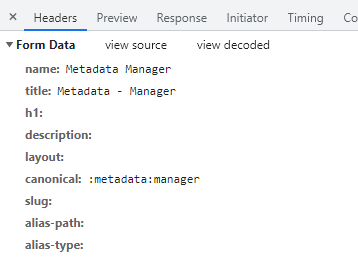About
FormData is a web api object that represent the data of a form that should be send if the form is submited.
Therefore if you have a checkbox that is not checked, formdata will not collect it.
You can create/build it and :
- send it in a Http request (XMLHttpRequest.send() method)
- use it in a form validation
As javascript object, you will get a set of key/value pairs representing form fields and their values.
When send, the data is encoded in multipart/form-data encoding 1)
It's part of the XHR specification 2)
Example
How to send a form data
- via Ajax XHR: You can also just send it via a Xhr request
var request = new XMLHttpRequest();
request.open("POST", "http://example.com/api");
request.send(formData);
- via fetch Api
let formData = new FormData(form);
fetch("/combo/api/v1.0/publication/subscription", {
body: formData,
cache: 'no-cache',
method: "post",
mode: 'no-cors',
redirect: 'follow',
credentials: 'same-origin'
})
.then(response => console.log(response))
Build from the form
- The form (Return false to prevent the default action of the submit event - ie to not get a 404)
<form id="form1" onsubmit="handleSubmit(this); return false;">
<input name="user" type="text" value="Foo" />
<input name="age" type="number" value="10" />
<input name="button" type="submit" value="Let mee see the input data !" />
</form>
- The event handler that will handle the submit event and loop over the entries iterator
The FormData constructor takes a form element as parameter. See FormData constructor Specification
handleSubmit = (form) => {
// build the formData object
let formData = new FormData(form);
// retrieve the entries in a entries variable of iterator type
let entries = formData.entries();
// loop over the iterator
let result = entries.next();
while (!result.done) {
console.log("Input: Name: "+result.value[0]+", value: "+result.value[1]);
result = entries.next();
}
}
- Result:
Management
Create
Manually
let formData = new FormData();
formData.append('username', 'foo');
formData.append('age', '10');
formData.append('tag', 'cool');
formData.append('tag', 'bar');
// You can't get all entries but you can get all values for one key
console.log(formData.getAll("tag").length);
Form
From a form, only successful form controls are included, i.e. those:
- with a name,
- not disabled
- checked for radio buttons and checkboxes.
- or selected one or more options within a select.
let formData = new FormData(document.getElementById('form1'));
From a key-value object
const formData = new FormData();
Object.keys(data).forEach(key => formData.append(key, data[key]));
Read
As iterator
The entries of a formData return an iterator.
Example:
let formData = new FormData();
formData.append('username', 'foo');
formData.append('age', '10');
// The entries function returns an iterator
let it = formData.entries();
- The loop (iteration)
let result = it.next();
while (!result.done) {
console.log(result.value);
result = it.next();
}
As an Object
const formJson = Object.fromEntries(formData.entries());
As an array of key-value pair
[...formData.entries()]
Browser Devtool
You can see it nicely formatted in the BrowserDevtool
Event
The formdata event is fired when:
- a form is constructing the entry list of the form data after the submit event. You could then add data in the list.
- a new FormData() constructor is created.
Example:
<form id="form1" onSubmit="handleSubmit(this); return false;">
<p><label>FirstName</label> <input name="firstname" type="text" value="FirstNameDefault"/></p>
<p><input name="button" type="submit" value="Let mee see the formDataEvent !" /></p>
</form>
- The FormData cannot cancel the action of a submit. Therefore, we take over the submit event, prevent it and build ourself the formdata.
let handleSubmit = (form) => {
console.log('submit event was fired');
// build the form data to fire the FormDataEvent on the form
new FormData(form);
}
- The event handler that will handle the formdata event
document.addEventListener("formdata", (formDataEvent) => {
console.log('formdata event was fired');
// Get the form data from the event object via values
let formData = formDataEvent.formData;
console.log("entries:");
for (var entry of formData ) {
console.log(entry[0]+" : "+entry[1]);
}
console.log("");
// Get the form data from the event object via get
console.log("Input is present ? : "+formData.has("firstname"));
console.log("Value via the name attribute is: "+formData.get("firstname"));
// You can also
// delete(name)
// getAll(name) (for multiple)
// set(name, value) and set(name, blobValue, filename)
// submit further the data via XHR
// let request = new XMLHttpRequest();
// request.open("POST", "/formHandler");
// request.send(data);
});
Construction Process
The formData is populated by following this procedure: constructing-the-form-data-set
